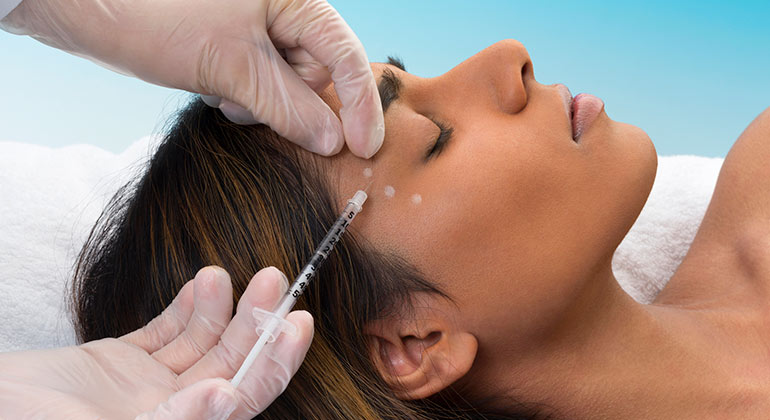Injectable Fillers: JUVÉDERM, RADIESSE, Restylane, and Sculptra Aesthetic

Mount Sinai’s highly skilled Facial Plastic and Reconstructive Surgery team is consistently at the forefront of the field making advancements that allow patients to achieve younger and healthier looking skin without surgical intervention. Injectable fillers—such as JUVÉDERM™, RADIESSE™, Restylane™, and Sculptra Aesthetic™— are used to fill in wrinkle lines or creases and replace lost volume in certain areas of the face.
Compared to injections like BOTOX™ that relax the facial muscles, fillers treat deeper creases and wrinkles by adding bulk or contour to the affected areas. Injectable fillers are the second most common minimally invasive cosmetic procedure in the U.S. More than 2.6 million people currently receive injectable fillers each year, according to the American Society of Plastic Surgeons.
Injectable Filler Practice at Mount Sinai
Technique is important to achieve the safest and most aesthetically pleasing results. At Mount Sinai, our board-certified facial plastic surgeons administer filler agents. As facial plastic surgeons, they have an in-depth understanding of facial anatomy and are highly skilled in targeting sensitive areas of the face, such as the nose, eyes, and ears.
Types of Injectable Fillers
The fillers available on the market are constantly changing. At Mount Sinai, we only use fillers that have been approved by the Food and Drug Administration (FDA). Patients have the option of using the following naturally occurring products:
- JUVÉDERM™ and Restylane™: These gel-like substances made from hyaluronic acids are naturally occurring compounds found in our bodies in between the cells.
- RADIESSE™: This substance is made from calcium hydroxyapatite gel microspheres that occur naturally in the human body.
- Sculptra Aesthetic™: The primary component, synthetic polymer made poly-l-lactic acid, in this substance has long been used in dissolvable suture material.
Conditions We Treat with Injectable Fillers
Adults of all ages may benefit from injectable fillers. They are commonly used to:
- Fill in deep creases, wrinkles, or scars including laugh and marionette lines
- Enhance areas of the face that lose volume as we age such as the cheeks and temples
- Improve the dark appearance of shadow lines and uneven pigmentation especially around the eyes and cheeks
- Enhance and “plump” the lips
- Improve the contour and shape of the nasal bridge and tip
- Define the jawline and chin
How Injectable Fillers Work
Over time, our skin naturally becomes thinner, we lose subcutaneous fat, and the face begins to sag with age. As a result, deep wrinkles and creases become more apparent and facial volume moves from the cheeks and upper face to the jawline, jowls, and neck. Injectable fillers are used to enhance certain parts of face such as the lips, while also providing volume that is lost as we age. The overall effect is to enhance beauty and/or create a fuller, more youthful appearance. Injectable fillers create excellent results with minimal downtime during a routine office visit.
Specific procedures performed with injectable fillers include:
- Cheek, lip, and temple enhancements
- Jawline refinement
- Nonsurgical/liquid rhinoplasty and/or brow lift
- Treatment of tear trough/under eyes and/or laugh and marionette lines
What the Procedure Entails
Any patient who is interested in cosmetic treatments at Mount Sinai will have an extensive consultation. Our team will identify areas of concern, review their goals, and develop an individually tailored treatment plan.
During the cosmetic treatment, patients will receive several small injections. Local anesthesia is administered using topical creams or injections to avoid discomfort. The entire procedure takes about 20 minutes, and can be performed during a routine office visit.
What to Expect After Injectable Fillers
Patients will see instant results after the injections. They can return to work and normal activity after the procedure. Some patients experience minor bruising. Fillers are not permanent. Depending on the substance used and the area injected, fillers may last for as little as six months or as long as four years.
Cost of Injectable Fillers
Cost is always a concern, as insurance does not generally cover surgery or treatment that is done purely for cosmetic reasons. Our team provides patients with expected costs prior to any intervention.